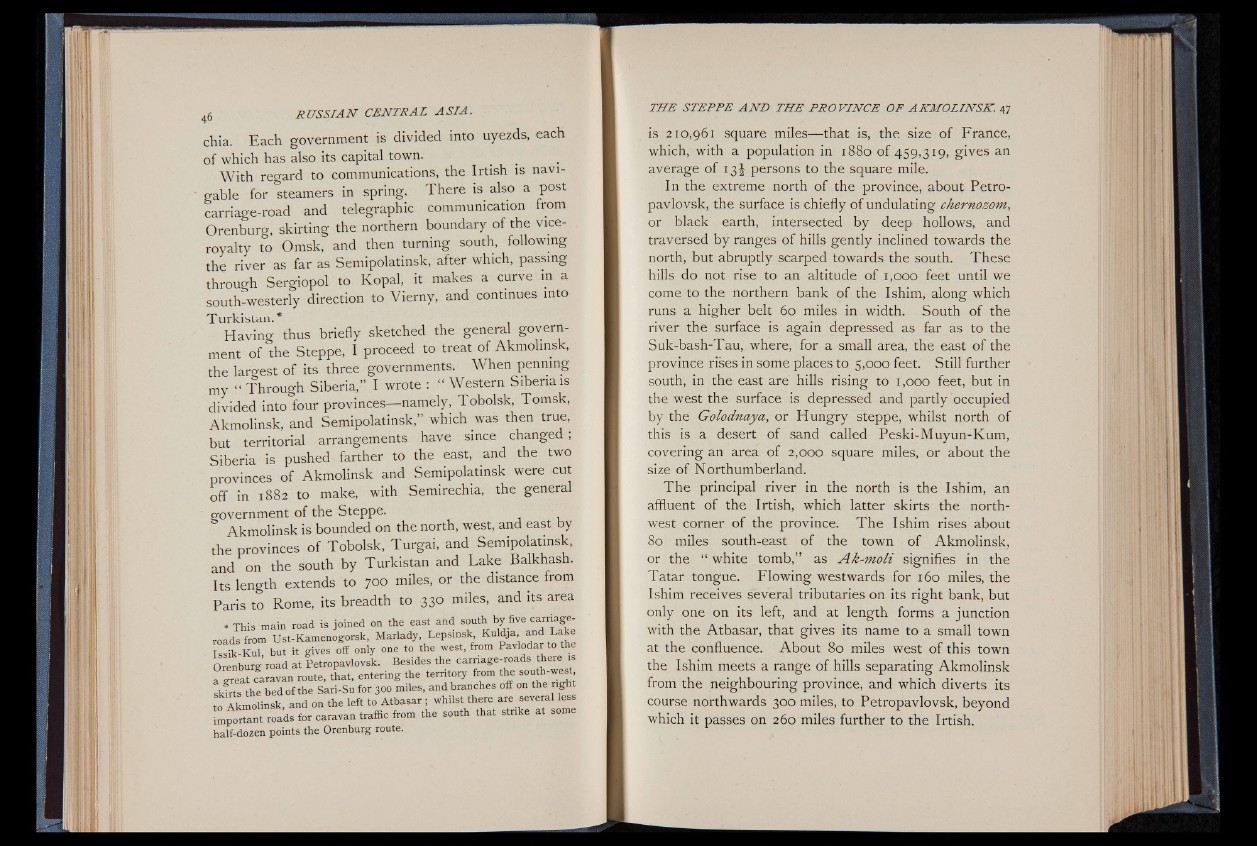
chia. Each government is divided into uyezds, each
of which has also its capital town.
With regard to communications, the Irtish is navigable
for steamers in spring. There is also a post
carriage-road and telegraphic communication from
Orenburg, skirting the northern boundary of the vice-
royalty to Omsk, and then turning south, following
the river as far as Semipolatinsk, after which, passing
through Sergiopol to Kopal, it makes a curve in a
south-westerly direction to Vierny, and continues into
Turkistan.*
Having thus briefly sketched the general government
of the Steppe, I proceed to treat of Akmolinsk,
the largest of its three governments. When penning
my “ Through Siberia,” I wrote : “ Western Siberia is
divided into four provinces— namely, Tobolsk, Tomsk,
Akmolinsk, and Semipolatinsk,” which was then true,
but territorial arrangements have since changed ;
Siberia is pushed farther to the east, and the two
provinces of Akmolinsk and Semipolatinsk were cut
off in 1882 to make, with Semirechia, the general
government of the Steppe.
Akmolinsk is bounded on the north, west, and east by
the provinces of Tobolsk, Turgai, and Semipolatinsk,
and on the south by Turkistan and Lake Balkhash.
Its length extends to 700 miles, or the distance from
Paris to Rome, its breadth to 330 miles, and its area
* This main road is joined on the east and south by five carriage-
roadsfrom Ust-Kamenogorsk, Marlady, Lepsinsk, Kuldja and Lake
Issfk-Kul but it gives off only one to the west, from Pavlodar to the
Orenburg road at Petropavlovsk. Besides the carnage-roads here s
a great caravan route, that, entering the territory from the south-west
skfrts the bed of the Sari-Su for 300 miles, and branches off on the right
to Akmolinsk, and on the left to Atbasar ; whilst there are several less
important roads for caravan traffic from the south that strike at som
half-dozen points the Orenburg route.
is 210,961 square miles— that is, the size of France,
which, with a population in 1880 of 459,319, gives an
average of 13 J persons to the square mile.
In the extreme north of the province, about Petropavlovsk,
the surface is chiefly of undulating chernozom,
or black earth, intersected by deep hollows, and
traversed by ranges of hills gently inclined towards the
north, but abruptly scarped towards the south. These
hills do not rise to an altitude of 1,000 feet until we
come to the northern bank of the I shim, along which
runs a higher belt 60 miles in width. South of the
river the surface is again depressed as far as to the
Suk-bash-Tau, where, for a small area, the east of the
province rises in some places to 5,000 feet. Still further
south, in the east are hills rising to 1,000 feet, but in
the west the surface is depressed and partly occupied
by the Golodnaya, or Hungry steppe, whilst north of
this is a desert of sand called Peski-Muyun-Kum,
covering an area of 2,000 square miles, or about the
size of Northumberland.
The principal river in the north is the Ishim, an
affluent of the Irtish, which latter skirts the northwest
corner of the province. The Ishim rises about
80 miles south-east of the town o f Akmolinsk,
or the “ white tomb,” as A k-m oli signifies in the
Tatar tongue. Flowing westwards for 160 miles, the
Ishim receives several tributaries on its right bank, but
only one on its left, and at length forms a junction
with the Atbasar, that gives its name to a small town
at the confluence. About 80 miles west of this town
the Ishim meets a range of hills separating Akmolinsk
from the neighbouring province, and which diverts its
course northwards 300 miles, to Petropavlovsk, beyond
which it passes on 260 miles further to the Irtish.